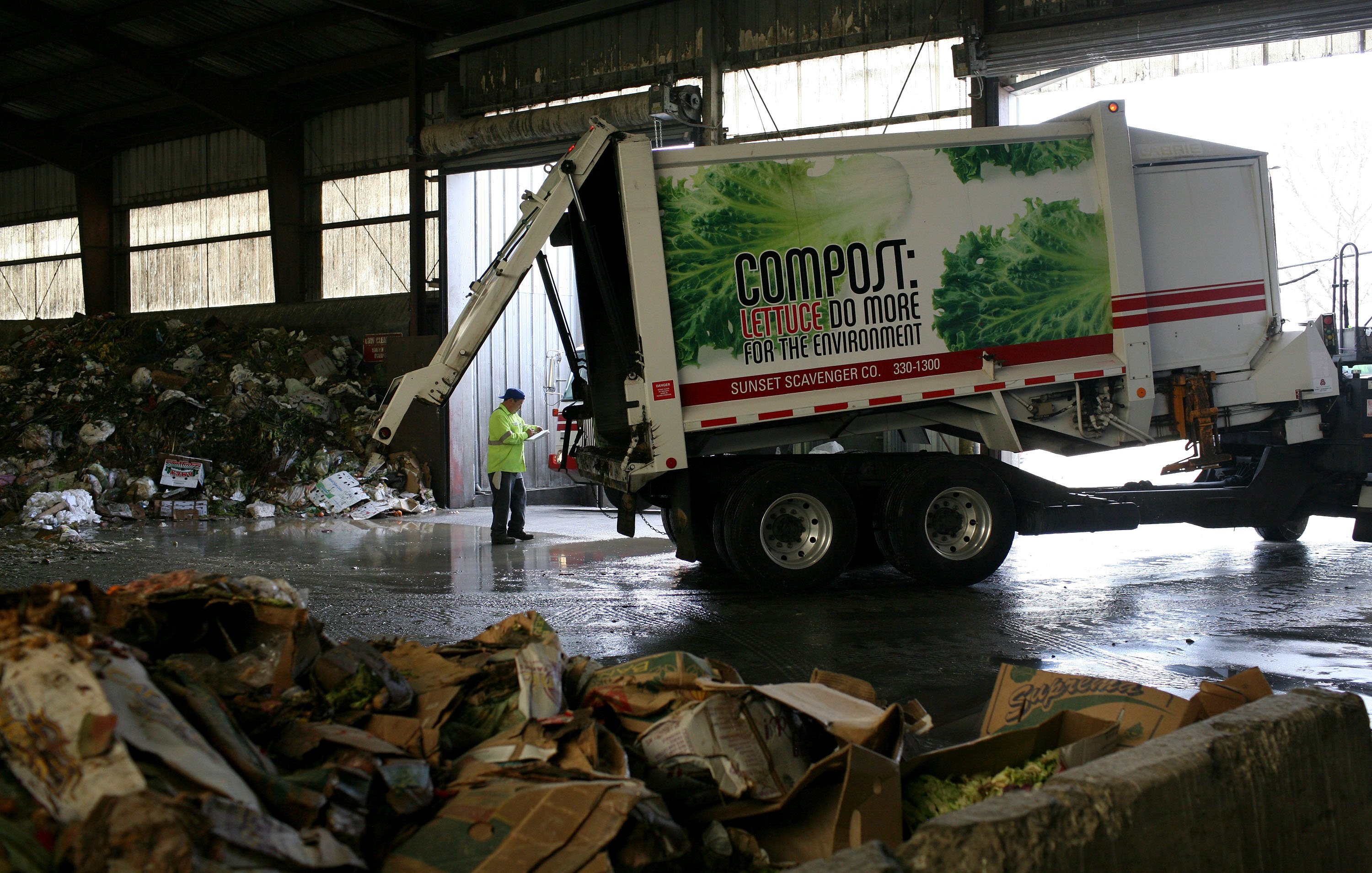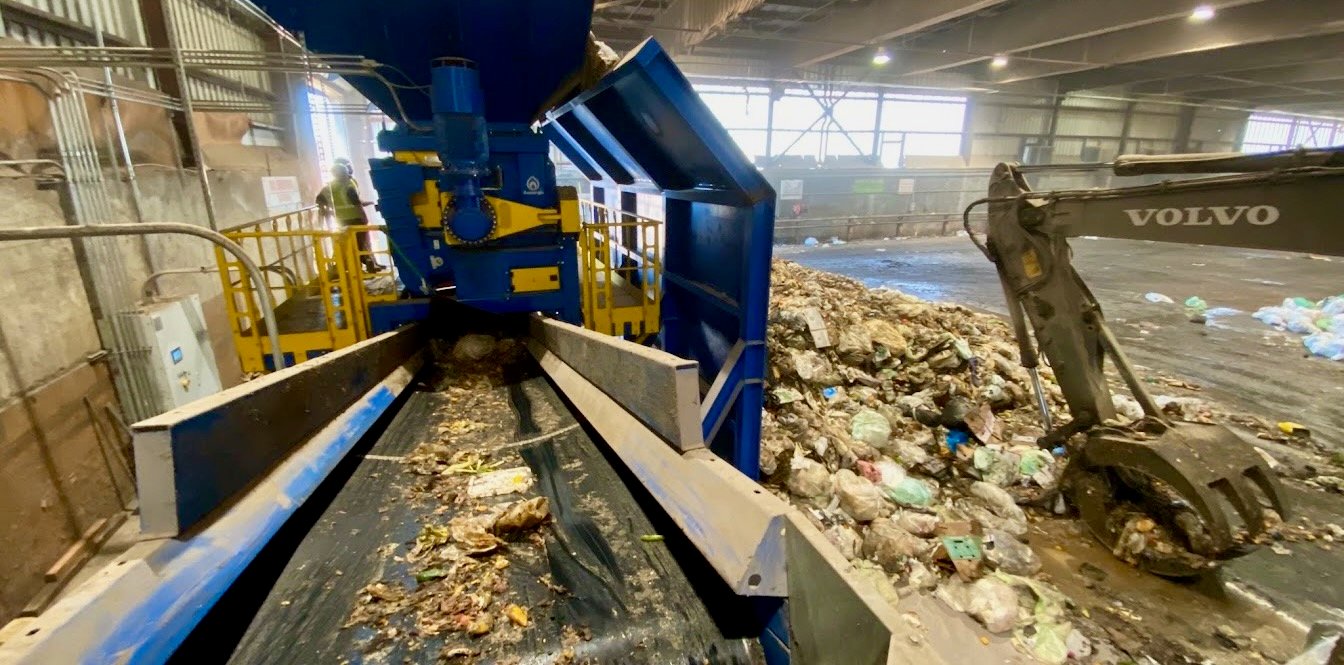Editor’s note: This is the fifth in a multipart series exploring the market effects of California’s sweeping organic waste reduction law, SB 1383.
California’s biggest waste policy shift in years offers various pathways to compliance, but it’s largely modeled off organics recycling efforts in one region: The San Francisco Bay Area.
While some of the state’s southern jurisdictions are newer to offering the full range of organics recycling services, many of their northern counterparts have been doing it for years — if not decades. With the exception of certain programs in cities such as San Jose, jurisdictions in the region are primarily focused on source-separated collection. Questions have been raised about the maximum diversion potential of this method, leading at least one city to explore additional sorting of its residual waste, but program operators say it’s the best approach. Rather than worrying about launching full collection programs like many of their colleagues around California, they’ve instead been more focused on boosting edible food recovery and waste reduction efforts to further optimize these systems.
Local officials in four of these areas share insights about how their programs have evolved over time and what the past year of SB 1383 preparation has entailed.

San Francisco organics recycling messaging from 2009
Justin Sullivan via Getty Images
San Francisco
The Bay Area is known for having some of the state’s longest-running curbside organics programs, but one in particular is often touted as a paragon of what’s possible.
“When [state regulators] were developing the regulations, they looked at San Francisco as a model, so basically they’re asking the entire state to do what we’re doing,” said Jack Macy, senior zero waste coordinator with San Francisco’s Department of the Environment, during a recent webinar hosted by the Climate & Clean Air Coalition.
The city first piloted curbside organics collection in the late 1990s. It launched citywide service in 2000 and made participation mandatory in 2009. Customers are given kitchen pails and compostable liner bags to facilitate the process; the city’s standard collection setup now offers larger bins for recyclables and organics than for landfill-bound waste. Recology (the city’s sole franchise hauler) sends an estimated 550 tons per day to be composted at its Blossom Valley Organics North facility outside the city in Vernalis. The company estimates San Francisco’s program has kept an estimated 2.5 million tons of organic material from disposal over its lifespan.
Recology began using cameras to monitor contamination from certain large waste generators in 2019 as part of an ordinance update that year, and the city has the option to assess fees as needed. But ensuring quality participation is still an ongoing challenge. While the SB 1383 regulations specify that gray refuse bins can have no more than 25% organics on average (when using the performance-based collection model), the state’s star city isn’t always hitting that mark. Macy said some neighborhoods perform higher than others. He confirmed that San Francisco will be pursuing compliance through the standard collection model, but he also believes the city could potentially meet the performance-based threshold.
“We have over 99% of all properties compliant in having adequate service for organics collection, which includes some exceptions we allow for very small businesses that demonstrate they do not generate organics or have arranged to share organics service with another entity,” Macy wrote via email. “We don’t track ongoing set out participation rates nor do we measure total recovery rates citywide as that would be very complex and expensive to do. We do estimate that we are recovering over 75% of all organics in the city based on some characterization work that was done recently.”
Recology spokesperson Robert Reed declined to answer a question about whether the company believes 75% organics diversion is achievable and did not engage on a question about whether the company thinks additional sorting of the gray bin will be necessary to achieve the goals of SB 1383.
Macy said he sees value in potentially sorting the residual mixed waste stream to capture more material — and San Francisco has considered this — but only when it’s done after a source-separated collection process.
“I think we can continue to do better and you can never do too much outreach,” he said. Macy cited population turnover, multifamily buildings, a diverse multilingual population and a large, varied commercial sector as particular challenges. “We have a long track record, but we don’t necessarily have all the answers.”
In a sign of how complex SB 1383 compliance can be even for jurisdictions with long-running programs, Macy said the city has been working to prepare for other elements of the regulations, such as organic waste product procurement requirements, edible food recovery and recordkeeping. Last month, the San Francisco Board of Supervisors passed a law that will require certain commercial generators (such as restaurants and grocery stores) to recover edible food. The goal is to provide an estimated 7 million pounds of edible food to hungry people per year, on top of existing work that has been underway with assistance from a state grant.
Oakland
Nearby Oakland is also a commonly-cited jurisdiction that has done organics recycling for many years, though with a different approach from San Francisco.
The city has offered residential green waste collection since the mid-1990s and began allowing the co-collection of food scraps in 2005. On the commercial side, source-separated organics collection also started to become available in the late 1990s. Residential material is composted in a covered aerated static pile system at WM’s Altamont Hill Landfill in eastern Alameda County, while commercial material goes to a new WM facility in San Leandro that is regularly cited as one of the most expensive facilities of its kind in the state.
After decades of source-separated collection for food and yard waste, but prior to the passage of SB 1383, the city decided to construct a mixed-waste processing facility for further sorting of landfill-bound waste as part of a 2014 contract update. The decision sparked controversy, in part because detractors felt that having this backstop would discourage educational efforts on source separation.
After a complex lawsuit, WM ended up winning the contract and built an expensive new MRF in San Leandro to sort landfill-bound waste for material that could be recovered. That facility, the Davis Street Resource Recovery Complex, is now the destination for Oakland’s commercial organics, which are processed in a fully enclosed system.
Peter Slote, Oakland’s solid waste and recycling program supervisor, said the contract was designed to encompass both MSW and organics. A separate contract for recyclables, now managed by California Waste Solutions, was designed so the winner of the MSW and organics contract would not be competing with itself on diverted tonnage. The facility is still in its early days, after ramping up to an initial opening last year, but it’s capturing additional material, according to the company and the city.
Slote said he does not anticipate this facility will be seeking “high diversion” status under the SB 1383 regulations, nor will Oakland be pursuing a performance-based compliance plan that exists for certain types of mixed waste collection. WM has said it’s too early to share specific results from the Davis Street facility in terms of compost quality or other factors, but multiple company representatives have described this particular facility as unique.
“It’s great technology to use if that is what your public policy is aiming towards,” said Alex Oseguera, the company’s director of government affairs in California, referring to maximizing diversion rates. “But in most settings, will [such facilities] be able to utilize the technology if they’re away from major city centers and populations? It would be more difficult to pay for that type of facility.”
When asked whether Oakland is hitting a performance ceiling on its source-separated collection program and thus has resorted to sorting residual waste, the city did not offer specific engagement data. Instead, Slote pointed at trends in lower disposal-bound volumes as the key way to measure if this is working over time.
“Our top three strategies are source separation, source separation and source separation,” he said. “When a community like Oakland has the 20- to 30-year investment and track record, you can take me at my word that we’re not anticipating failure.”
Alameda County
Other Bay Area jurisdictions that feel their collection programs are more established are also looking for ways to keep advancing. StopWaste — a joint powers authority representing 17 agencies in Alameda County, including Oakland — has reoriented its approach in recent years to support that mission.
“Focusing on stuff when you’re done with it is going to be challenging, no matter what,” said Jeff Becerra, then-communications manager for StopWaste, who recently retired. “We made an intentional shift to focus more on the waste prevention so, basically, you have less of that stuff to deal with at end of life.”
StopWaste does this through a range of grants, technical assistance programs and other efforts to work with residents, businesses and schools on initiatives such as reuse and repair, not just recycling. Like some other jurisdictions with existing organics programs, StopWaste said its members have been more focused on setting up systems for edible food recovery, procurement and recordkeeping. As of this spring, all StopWaste jurisdictions have SB 1383 ordinances in place and the authority has also completed a food donation capacity study.
Alameda County has banned the landfilling of plant debris since 2010; it made organics recycling mandatory for commercial and multifamily buildings in 2020 and offers source-separated collection for other residents across StopWaste’s member agencies. While members aren’t notably concerned about their collection efforts being compliant with SB 1383, according to the entity, StopWaste doesn’t have data available about their performance. Like Oakland, it will be monitoring disposal volume trends as one metric.
“Reducing organics to landfill has been a goal of ours for a number of years, and we do want to figure out an accurate and manageable way to measure it,” said Becerra. “Hopefully, there’s going to be mechanisms within 1383 to have these conversations with CalRecycle over time.”

OREX press at SBWMA facility
Permission granted by RethinkWaste
San Mateo County
For the neighboring South Bayside Waste Management Authority, known as RethinkWaste, this question of how to measure success for California’s ambitious law is top of mind.
The entity facilitates operations for 11 jurisdictions in San Mateo County on the peninsula between San Francisco and San Jose. Curbside organics recycling has been in place for residents and businesses since 2010 through a three-bin system collected by Recology. Until recently, all of the co-collected organic material went to be composted at Republic Services’ Newby Island Organics Facility and Recology’s northern Blossom Valley site. Yet even with a 12-year history, the program hasn’t necessarily received full buy-in.
“There’s not much food waste in the yard waste that comes from residents,” said Hilary Gans, senior operations and engineering manager at RethinkWaste. “Participation in food waste diversion from their households is pretty minimal.” As a result, Gans said, the gray carts in his area likely have more than 25% organic content on average.
Recently, the authority installed an OREX press (manufactured by Anaergia) at its facility and is sending slurried material from commercial streams to a nearby wastewater treatment plant for digestion. Gans said this makes sense because the commercial system has minimal green waste and higher percentages of trash, which can be a struggle for composters to manage.
Given these operational realities, Gans is interested in the concept of a high diversion organics processing facility (which could open up potential to sort the gray bin) but he’s concerned the regulations are written to make that possibly “unachievable” because unique categories such as paper, textiles and wood are included in the definition of organic waste. Gans said he believes the better strategy would be to include paper as a designated material for blue bin recycling, as this is causing confusion in collection and processing planning.
While the regulations technically allow different approaches, it’s clear that three-bin collection is considered the default option. In Gans’ view, modeling an entire state program on how San Francisco does organics collection may not necessarily lead to the intended results for all jurisdictions, as it’s not the typical California city and he considers it “essentially an outlier.”
Because SB 1383’s main compliance mechanisms focus on whether jurisdictions have collection programs in place, and the regulations don’t call for direct measurement of how much organic material is going to disposal, Gans sees a potential challenge in the future depending on how officials approach the task in front of them.
“1383 doesn’t mandate any quantitative diversion, it just says you need to set up programs and CalRecycle’s going to monitor whether you’ve got those programs. And if you’ve got those programs, you’re good,” he said. “If cities don’t put in a good-faith effort, we won’t see the diversion that we are expecting, and, therefore, the organics will just continue to go to the landfill.”
Stay tuned for Part 6, which will wrap up our series with a look at what SB 1383 could mean for the business models of waste and recycling operations in California and beyond.


